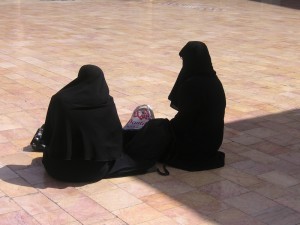A Decade in Power, part 3: In Grip of Poverty and Religion. Social trends under Bashar al-Assad


Under Bashar al-Assad, Syrian society has undergone significant change. In addition to Islam’s growing influence, there is a widened gulf between the classes. While the staunchly secular authorities are becoming wary of the growing religiosity and fight it with determination, the state’s capacity to provide social welfare for the growing number of poor seems weak.
Every year, Damascus, like the rest of the Islamic world, celebrates the birthday of the Prophet Mohammad. People tune into religious chanting on the radio. Some distribute typical Damascene sweets to strangers and ask passersby to praise the Prophet. Balconies become draped with the green flag of Islam and banners bearing verses from the Koran fill the streets.
Syrians have always marked this occasion, but in the last ten years the festivities around it have become more evident – which, observers say, is a sign of Islam’s increasing influence in Syrian society.
At the same time, there have been indications that the staunchly secular authorities are becoming wary of the growing religiosity. In recent weeks, the government banned female students from attending public and private universities wearing the Niqab (a veil covering the face) and dismissed 1200 school teachers for wearing the garment.
Some observers said the moves were an attempt by the government to preserve the moderate Islamic character of the country in the face of a fundamentalist threat.
But others argue that the Niqab has long been a social tradition in some parts of Syria and in no way suggests the country is moving in a radical Islamic direction.
Several commentators accused the authorities of trying to win support in the West by portraying themselves as a buttress against extremism, especially since a number of European countries are currently debating whether to ban the Niqab from public places and state institutions.
Whether cast as a fundamentalist trend or a reconnection with Islamic traditions, there’s little doubt that Islam is having a bearing on the lives of many Syrians.
Preachers: The New Rock Stars
Not only are more and more women wearing the veil, but there has been an upsurge in the number of people attending religious classes held by mosques and Islamic institutes across the country.

The popularity of preachers, like Sheikh Nabulsi, who deliver sermons and dispense religious advice on radio and television stations, has been increasing. Using simple and accessible language, this new breed of clerics has drawn mainly young audiences.
Booksellers say that books preaching the Islamic way of life or explaining religious texts are among the best selling publications.
Women’s identification with Islam has to a large extent been influenced by the spread of the Qubaysiat religious circles – a movement that started out with women giving religious lessons to other women in their homes, but in 2006 was given permission by the government to set up schools and teach in mosques.
One reason for the growing place of Islam in society, experts say, is that the Syrian government has consistently sought to exclude ordinary people from the public sector and politics, driving many to seek solace in religion.
Some also say that authorities have actively encouraged the spread of religion – for instance touting apolitical preachers – while repressing any form of political Islam.
Back in the 70s and 80s, Hafez al-Assad, the late Syrian ruler, crushed his political foes, the Muslim Brotherhood. Thousands were killed, imprisoned, kidnapped or exiled for taking part or even sympathising with the Islamic group in those years.
To this day, Muslim fundamentalists are amongst the most repressed political dissidents in the country. And the authorities have tightened their grip over Islamic charities and institutions.
In Syria, some say that the roots of today’s growing piety – at least in the capital – goes back to 1970 after Assad took the reins of power. His regime closed down cinemas and other cultural institutions which he regarded as a threat to the national identity of the country. At the same time, the social fabric of the big cities changed with the influx of waves of rural people in search of better lives.
In the 1980s, another new factor emerged. Society became more accustomed to the stricter Islamic values of Persian Gulf countries as large numbers of Syrians went to look for jobs in these deeply conservative oil-rich nations.
Growing Poverty
In addition to Islam’s growing influence, society has experienced a widened gulf between the classes.
The last decade has seen a significant shift in the country’s economic policies, which have become more market oriented.
The social impact has been significant. While Damascus and other big Syrian cities today boast world-class restaurants and hotels, flashy sports cars and glitzy boutiques, observers say working-class Syrians have seen little benefit.
Official figures show that the underclass is expanding; that around 12 per cent of Syrians live below the poverty line. Some observers believe that the actual figure is higher, perhaps 40 per cent of the population.
To date, the most comprehensive study of poverty in Syria conducted between 1996 and 2004 shows that 11.4 per cent of people, or 2.2 million of Syria’s 21 million population, lived in extreme poverty, defined as being unable to obtain their basic food and non-food needs, or to live on less than two US dollars a day.
One of the most obvious signs of poverty is the sprawling shantytowns where electricity, water and sanitation services are poor.

This situation has been exacerbated in recent years as a severe drought has forced hundreds of thousands of poor peasants to abandon their land for makeshift encampments on the outskirts of the cities.
Meanwhile, posh suburbs with modern villas and malls have sprouting around the outer suburbs of Damascus to accommodate the emerging rich.
Many blame the widening income gulf on government policies favouring the wealthy. In addition, some say entrenched corruption, nepotism and a monopoly held by a handful of well-connected businessmen hinders a fairer distribution of wealth in the country.
Experts say that while new investments have created few jobs, soaring living expenses –especially housing costs – over the last five years have driven many Syrians to look for second jobs to make ends meet. This at a time when ordinary people have seen cuts in government subsidies for fuel and some food items.
Population Growth
The gap in living standards is likely to widen with galloping population growth, which between 2006 and 2010 was 2.37 per cent, one of the highest levels in the world. The authorities are struggling to find jobs for the legions of youngsters entering the workplace every year. The most recent official figure for unemployment is 8.5 per cent. But independent observers say that real number is much higher.
Also, the state’s capacity to provide social welfare, in particular free education and health insurance, which were once the hallmark of the Baath regime, might soon crumble. Many already complain about the poor quality of public hospitals, schools and universities.
